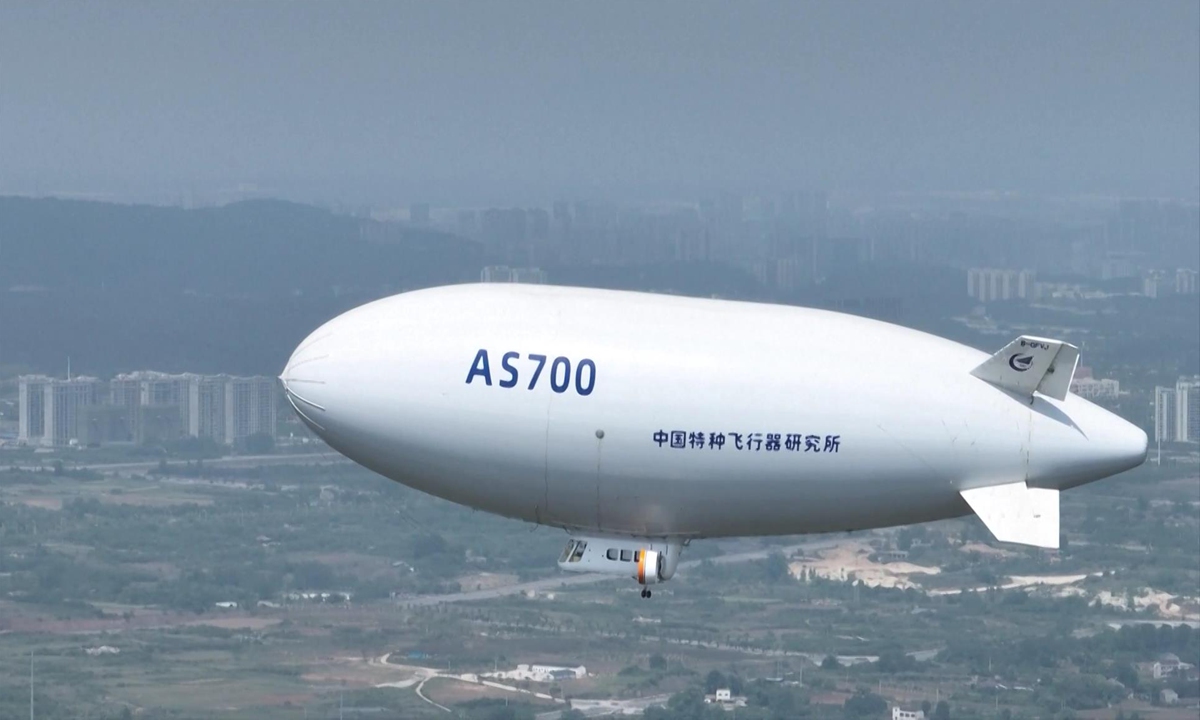
China's first self-developed civil airship, the AS700 Xiangyun, successfully completes its first demonstration flight in a low-altitude tourism application scenario in Jingmen, Central China's Hubei Province, on August 1, 2024. The flight marks a new stage in the industrial application of this technological innovation project. Photo: VCG
Chinese enterprises, industry associations and localities are moving to boost the low-altitude economy through a wide range of measures amid the sector's rapid expansion.
As the low-altitude economy integrates a wide range of industries and application scenarios, observers noted that the emerging industry will play a vital role in shoring up the country's economic development, buoyed by technological innovation, continuous industrial upgrading and new opportunities.
In the latest move, China's low-altitude economy alliance was officially launched in Beijing on Saturday, jointly founded by more than 100 upstream and downstream enterprises and industry research institutes, Chinanews.com reported on Sunday.
Luo Jun, executive director and secretary general of the alliance, said at the launch ceremony that developing China's low-altitude economy has a significant meaning in promoting economic restructuring as well as transforming and upgrading traditional industries.
As the industry is still at its early development stage, Luo said that the alliance will work with hotspot cities to create application scenarios that can be replicated quickly, assist relevant departments in formulating industrial standards, and improve supporting facilities by utilizing its guiding and leading role in the sector.
Since the low-altitude economy is a relatively emerging industry, China's efforts in driving up the industry's development will have a guiding effect globally, Zhang Yi, CEO of the iiMedia Research Institute, told the Global Times on Sunday.
Specifically, the rapidly expanding sector has been advancing mainly in battery technology, aircraft development, and improvements in matching infrastructure construction and supervision, Wang Peng, an associate research fellow at the Beijing Academy of Social Science, told the Global Times on Sunday.
Also on Saturday, Chinese start-up AutoFlight and domestic battery producer Contemporary Amperex Technology Co (CATL) signed a strategic investment and cooperation agreement. CATL will become a strategic investor in AutoFlight with an exclusive investment of hundreds of millions of dollars, AutoFlight said on its official WeChat account.
The two companies will work together on the research and development of aviation batteries for electric vertical take-off and landing aircraft (eVTOL), with a focus on improving the energy density and performance of the battery, supporting eVTOL with a longer flight distance and higher load capacity, and significantly elevating safety and stability.
The expanding investment in the low-altitude economy demonstrates the sector's market vitality in attracting diverse entities. The technology-driven investment represented by the cooperation between AutoFlight and CATL is crucial to propel the industry's development, while upstream-downstream integration will help form an improved and more efficient ecosystem, according to Wang.
Besides the technological advancements made by various companies, Wang noted that China's improving support targeting low-altitude airspace management, infrastructure construction and corresponding flight service guarantees have provided strong backing for the sector's large-scale, commercialized development.
The new industry will also promote coordinated regional development, as the sector's flexibility and efficiency will alleviate traffic congestion and enhance inter-regional connectivity. The adaption of new transportation means such as drones and eVTOL will elevate social services, especially in areas such as medical and emergency rescue and logistics distribution, Wang said.
The low-altitude economy was defined as a strategic emerging industry at the country's annual central economic work conference in 2023 and written into this year's government work report as a new growth engine. Relevant departments and localities have been implementing corresponding policies and plans.
Shenzhen, South China's Guangdong Province has been a pivotal city in advancing the local expansion of the sector. The city has released multiple road maps covering the low-altitude sector's development from various aspects, including infrastructure, operating systems, the industrial ecosystem, application scenarios and others, the Xinhua News Agency reported on Saturday.
As of June, Shenzhen had built 249 low-altitude takeoff and landing sites and opened 207 drone routes. The city will continue to expand application scenarios for logistics, manned transportation and emergency rescue, aiming to operate 1.5 million low-altitude cargo flights and more than 30,000 low-altitude manned flights in 2025, according to the Xinhua report.




